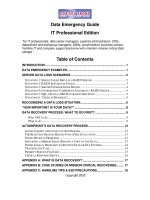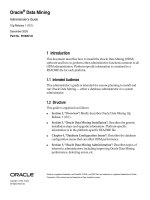Data emergency guide
Bạn đang xem bản rút gọn của tài liệu. Xem và tải ngay bản đầy đủ của tài liệu tại đây (379.42 KB, 22 trang )
Table of Contents
INTRODUCTION. . . . . . . . . . . . . . . . . . . . . . . . . . . . . . . 3
WHAT IS DATA LOSS? . . . . . . . . . . . . . . . . . . . . . . . . . . . 5
WHAT IS DATA RECOVERY?. . . . . . . . . . . . . . . . . . . . . . . . 7
DATA LOSS PREVENTION. . . . . . . . . . . . . . . . . . . . . . . . . 9
RECOGNIZING A DATA LOSS SITUATION. . . . . . . . . . . . . . . 15
DATA RECOVERY PROCESS: WHAT TO DO FIRST?. . . . . . . . . . 18
DATA EMERGENCY WORKSHEET . . . . . . . . . . . . . . . . . . . . 20
ACTIONFRONT’S DATA RECOVERY PROCESS . . . . . . . . . . . . . 25
CASE STUDIES: REAL LIFE DATA RECOVERY STORIES. . . . . . . 28
APPENDIX A: VENDOR HELP REFERENCES . . . . . . . . . . . . . 33
APPENDIX B: RELATED REFERENCES. . . . . . . . . . . . . . . . . 34
APPENDIX C: HANDLING TIPS & ESD PRECAUTIONS. . . . . . . 35
APPENDIX D: BEWARE DIY SOLUTIONS AND PRODUCTS. . . . . 36
APPENDIX E: HOW TO CHOOSE A DATA RECOVERY COMPANY. . 37
OUR PITCH . . . . . . . . . . . . . . . . . . . . . . . . . . . . . . . . 39
Copyright 2002
1.800.563.1167 www.actionfront.com 1
Emergency Information
Recognizing a Data Loss Situation
What To Do First
What NOT To Do
Data Emergency Worksheet
Introduction
This guide is intended to help you recognize, react
appropriately to and resolve a data emergency.
It is not a technical support manual for the installation,
configuration and upgrading of data storage devices and
platforms, nor is it a how-to manual for data backup
procedures.
The Data Emergency Guide will be most useful to computer
users and technical support personnel experiencing a sudden
data loss situation involving a previously functioning
computer system or backup, or dealing with the accidental
erasure of data or overwriting of data control structures.
For general technical support and/ or consultation on proper
backup systems please consult your data storage vendor or
your local computer systems supplier/ integrator.
This guide does include some excellent reference materials
about data storage, backups and data loss prevention, with
links to additional reference materials and links to vendor
technical support.
The Importance of Data Storage
Data Storage is the holding of information in a digital format
on a device or system of devices that are within or attached
to a computer system. Examples of data storage devices range
from those found on personal computers such as a hard drive,
a floppy diskette, or a CD-ROM to those found in sophisticated
corporate data centers such as large multi-hard drive servers
and automated backup libraries. Data storage is an integral
component of all computer systems and modern life, as we
know it, would not exist without it.
The types of information stored can range from simple one-
page documents belonging to an individual, up to and
including huge commercial databases consisting of millions of
records serving thousands of users.
There can be cost savings when replacing paper records with
digital records, however the key benefits of digital data
storage are the efficient change, replication and sharing of the
stored information. For example, a personal user can update
and send a resume in minutes to respond to different
opportunities. A geographically disparate product supply
chain involving multiple companies can collaborate effectively
on a just-in-time inventory requirement.
1.800.563.1167 www.actionfront.com 32 ActionFront Data Recovery Labs
What is Data Loss?
A data loss situation is usually characterized by one (or more)
of the following:
• The sudden inability to access any data from a previously
functioning computer system or backup.
• The accidental erasing of data or overwriting of data control
structures.
• Data corruption or inaccessibility due to physical media
damage or operating system problems.
Data loss can be caused by physical damage or “soft” (logical)
problems. For example:
• A personal user can no longer access the “C:” drive on their
PC or no longer read a floppy disk.
• A corporate data server has crashed and no longer serves
data to the corporate network.
• A set of medical images backed up on a digital tape
cartridge can no longer be restored.
Have you experienced data loss?
If your answer is “yes”, then you are not alone! The majority
of computer users will encounter this situation at some time.
Physical Causes of Data Loss
Approximately 70% of data loss cases processed by
ActionFront were caused by physical problems.
Occasionally manufacturing defects or design flaws can cause
mechanical or electronic failures. Most physical problems can
be traced to other root causes.
Physical problems include mechanical failures due to:
• Shock from device being bumped, dropped or moved while
operating causing a head crash or platter misalignment.
• Device exposed to extreme cold temperatures and/ or rapid
temperature change prior to use. For example powering up a
laptop after being in a freezing car overnight.
• Disasters such as flood, fire (including sprinkler-water
secondary damage) and explosion.
• Stiction: The read-write head assembly gets “stuck” on the
disk media due to deterioration of the lubricant or because
it has failed to retract to its rest (parked) position.
Physical problems also include failure of electronic
components on the drive’s controller board due to:
• Electrostatic Discharge (ESD) or heat.
• Power loss or power surge.
1.800.563.1167 www.actionfront.com 5
Of course a business can become totally dependant on the
application that uses the data storage in their computer
system. Losing access to that data can have costly and even
catastrophic consequences. A personal user can lose work
that took days, weeks or longer to produce if they experience
data loss. Sometimes the data cannot even be re-created.
Data storage systems can be large, sophisticated installations
of almost overwhelming complexity. Despite redundancy and
backup, they can be fragile and unreliable due to human error,
adverse environmental conditions and occasional device
failure. Even the smartest and most experienced technicians
working with the best data storage equipment experience data
loss.
4 ActionFront Data Recovery Labs
What is Data Recovery?
It may not be what you think it is!
Many people equate data recovery with restoring data from a
tape backup, or use the term “data recovery” interchangeably
with “disaster recovery” as in recovering from a major disaster
such as a flood, fire or bombing attack. These meanings are
quite true in the general sense and “data recovery” is usually
one step of the “disaster recovery” process.
However, the term ”Data Recovery” has a very specific
meaning in the computer industry. First, consider one of the
dictionary’s definitions for “recovery”.
“Recovery” noun.
“The act of obtaining usable substances from unusable
sources.”
Based on this, ActionFront offers the following definition.
“Data Recovery” noun.
“The act of obtaining usable data from downed computers and
backups.”
Data recovery cases can be divided into two broad categories:
Common Recoveries
Involve floppies and hard drives that are usually from single-
user personal computers.
Complex Recoveries
Involve hard drives, RAID arrays, tape and optical media or
corrupted databases and file systems usually from multi-user,
business systems. Data storage at the high-end has become a
very complex field. In the case of these complex situations
data recovery can be seen as “troubleshooting data storage”.
Whether common or complex, each data recovery case is
unique and the process can be very resource intensive and
exceedingly technical.
1.800.563.1167 www.actionfront.com 7
Physical problems affecting the computer equipment may also
render data inaccessible even though the media (that it is
stored on) still functions perfectly:
• Sudden power loss may corrupt open database files.
• Computer memory glitches may result in bad data being
written to sensitive filesystem control areas.
“Soft” Causes of Data Loss
“Soft” causes in this context means non-physical causes.
These are also referred to as “logical” causes. Soft problems
can usually be related back to something that someone did or
did not do, in other words “human error”. Oops!
• Accidentally deleting files or reformatting the system.
• A tape containing a good backup was partially overwritten
because it was inserted out of sequence during a tape
rotation.
• “Failed restore”. Restoring from a backup can be a lengthy
and error prone process. This can include tape format or
compression errors.
• Viruses. The malicious work of a smart sociopath.
• Configuration errors due to the complexity of the system.
6 ActionFront Data Recovery Labs
Data Loss Prevention
Data loss is extremely disruptive to both individuals and
businesses and data recovery can be an expensive process. It
is therefore in your best interest to take the time and invest
the resources needed to prevent data loss. In general:
Back Up Your Systems
Whether you use a single notebook or desktop computer or are
responsible for the corporate server, backing up your data is
fundamental to prevent data loss. Backing up data means
making a copy of critical data onto some other media and
storing the back up separately from the main file set in use.
Practice Restoring from a Backup before you need it.
“My backup worked fine, however the restore did not”. This is
an old joke in the computer industry based on real life
disasters where someone diligently used a backup routine for
months or years with no hint of errors, then were unable to
restore the data when they needed it. No one ever tested the
backup to ensure that if it were ever needed, the restored
data would be usable. Ha Ha indeed!
Never Upgrade without a Verified Backup
Before upgrading any system, perform a complete backup and
restore procedure. Many data recovery cases involve upgrades
gone wrong. Prove that you can quickly restore the status quo
before embarking on an upgrade.
Document Your Systems
• List your applications and ensure that you are regularly
backing up the data from all of them.
• Organize all original software and hardware documentation
and original copies of software.
Practice Preventative Physical Maintenance
• Keep the equipment under favorable environment conditions
regarding temperature and humidity.
• Install protection from power outages and power surges.
• Clean the dust from the inside or your system.
• Cleaning tape and optical drives periodically through the use
of special cleaning disks and tapes.
• Take ESD precautions. (See Appendix C).
Practice Preventative Soft (Logical) Maintenance
• Delete unused/ unneeded software and data files.
• Defragment your hard drive. (See Disk Defragmenter in
“Windows Help”).
• Perform file systems checks. (See ScanDisk, CHKDSK, FSCK in
“Windows Help”)
• Deploy and keep up-to-date, anti-virus and firewall software.
1.800.563.1167 www.actionfront.com 98 ActionFront Data Recovery Labs
The more sophisticated users need to document their
specialized backup activities and make sure they can fully
restore their system. Again, help from a qualified technician
is recommended.
Data Loss Prevention for Business Users
If your business is dependant on its computer system to
function, then you need to make a “business continuance
plan”. There are consultants and companies that specialize in
this discipline if you have sophisticated needs requiring
outside help. At the core of any such plan is a list of
activities and resources that your business cannot be without
in order to function. If you experience an emergency such as
a server crash or a complete disaster, how will you keep
operating? A careful reading of this Data Emergency Guide
will yield many of the ideas you will need in your own
business continuance plan.
Issues that particularly apply to businesses include the use of
centralized servers to backup individual workstations and the
need for archival (long term) storage of frequently changed
data such as accounting records and databases.
Backup
For corporate mission-critical data this means setting up a
structured backup procedure whereby a complete copy of all
files (or sometimes just specific data files) is made, usually on
a tape cartridge, and storing it off-site. Some procedures call
for “incremental backup” of only the changed files,
interspersed with periodic complete backups. This procedure
calls for a strict rotation of clearly labeled tapes that supports
a smooth restore procedure should it be necessary. Particular
attention should be given to the type of backup software used
to ensure full compatibility with your operating system and
applications.
Restore
Any formal backup routine should be tested by a “trial restore”
during the normal course of operations. If you cannot afford
to risk any downtime with the system in question, try to
restore the contents of that system onto an alternate or spare
system. (If your application is mission-critical as this implies,
then you should be maintaining an alternate in any case. See
“redundancy” below.)
Redundancy
When it comes to engineering and computers, redundancy is a
good thing! When a pilot thinks of a redundant engine, it is
in the context that it will provide power to the aircraft,
should the other engine fail.
1.800.563.1167 www.actionfront.com 11
Pay Attention to Alarms
• Many hard drives and storage management software
programs provide “self-diagnostic” utilities to warn of
impending or actual failures while continuing to function.
Do not ignore these warnings. For example, a RAID server
may sound an alarm signaling that a drive has failed but
will still serve data since built-in redundancy automatically
takes over. This is intended to keep your system
functioning while you replace the failing or failed
component, not as a permanent solution.
Pay Attention to Security
• Are your systems adequately protected from theft or
vandalism of the physical kind?
• Are your systems adequately protected from Internet hackers
or disgruntled employees?
Prepare for Physical Disasters
• Take precautions to prevent or mitigate physical disasters
such as fire, flood or explosions. For example, do not situate
your server unprotected in a room underneath a potentially
leaky plumbing pipe!
• Make a “disaster recovery plan”. Where would you get the
necessary equipment to bring your system back up if your
current facilities were destroyed? Unfortunately, some
catastrophes cannot be foreseen, prevented or mitigated.
Data Loss Prevention for Personal Users
All of the general prevention measures listed above can be
used by personal computer users depending on the level of
importance they assign to their data. This section
recommends the simplest level of data loss prevention.
Backup
Casual personal users can simply copy important files to a
floppy disk, CD or other removable media, label it
appropriately and store it in case of future need, along with
the original copy of any and all software programs they are
using.
More sophisticated users may want to purchase a specialized
backup device (such as a tape drive) or perhaps use Internet
backup services to have “off-site” backup. They may want to
get some help from a qualified technician to plan and
implement a comprehensive backup routine.
Restore
A casual user using an informal backup method such as the
one described above can simply make sure they can read the
data they have made copies of.
10 ActionFront Data Recovery Labs
Effects of Data Loss
If they are unlucky or careless, a personal user can lose
countless hours of work or “priceless files” such as photos
that have a high sentimental value.
For the business user, the costs can be much higher and even
become a life or death issue for that business. And if a data
loss situation does not actually kill a business, studies show
that “downtime” costs could be in the thousands or millions
of dollars per hour.
The long-term storage, maintenance and ability to use original
data are formal regulatory requirements or at least a fiduciary
or ethical duty in many fields. This is especially true in
government, medical and financial environments.
1.800.563.1167 www.actionfront.com 13
For the largest corporations with huge financial resources,
redundancy means maintaining an alternate and remote data
center with an up to the minute copy of the corporate
application and data. A fail-over process will automatically
route all data processing activities to the alternate center
during an emergency.
If your business is dependant on its computer system to
function, then you need to make an investment in redundancy
as part of your business continuance plan. For example, a
small business will often re-purpose an older server as a
workstation. Can you restore a backup to this computer and
use it as the main server for a short period? A good
contingency plan will identify a work-around or backup for
each mission critical part of your business system.
Security
Businesses must consider both internal and external security
threats of both a physical and soft (logical) nature.
Internal and external physical threats should be addressed
through fire and flood proofing, and limiting access to various
facilities with a high level of security surrounding a separate
server room or data center.
External logical threats can be mitigated through the use of
hardware and software utilities such as firewalls and virus
protection.
Internal logical threats should be addressed through a
comprehensive password system that assigns access rights by
function. The system should be rigorously maintained and
tested periodically.
Human Resources
Each organization should designate one or more individuals
with the prime responsibility for data security and business
continuance. This person should:
• Document the business continuance plan and have it
reviewed and approved by senior management.
• Document backup and restore procedures.
• Test the restore procedures.
• Ensure compliance from the rest of the staff.
• Ensure that staff are qualified for these responsibilities and
have adequate time and resources to carry them out.
12 ActionFront Data Recovery Labs









